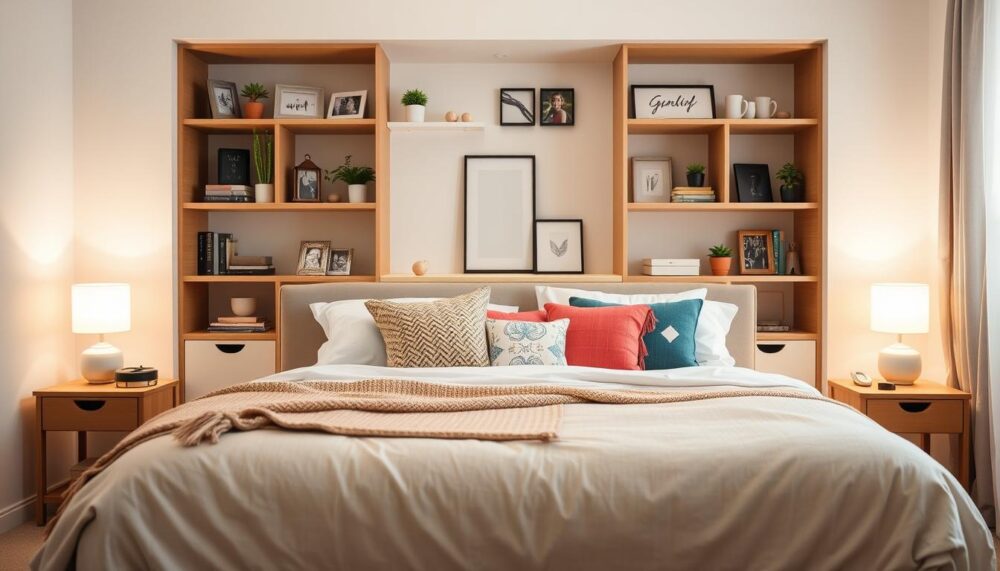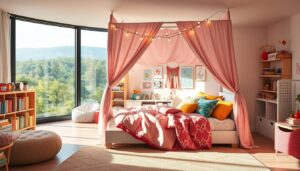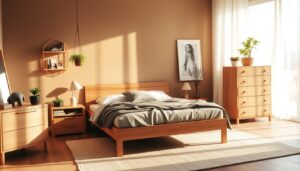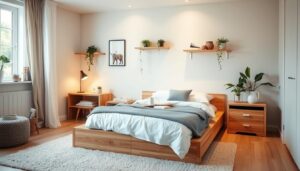Looking for clever ways to maximise space in your child’s bedroom? The reversible frame of this popular item offers endless creative possibilities. Its adaptable design makes it perfect for small rooms, allowing parents to craft unique solutions that kids adore.
From football-themed rooms to cosy study nooks, real-life examples show just how versatile it can be. Many families have transformed it into playhouses or themed hideaways without breaking the bank. Compared to custom-built furniture, it’s a budget-friendly choice with plenty of charm.
Key Takeaways
- Versatile reversible frame for creative children’s room solutions
- Space-saving design ideal for compact bedrooms
- Customisable for themed designs like playhouses or study areas
- Cost-effective alternative to bespoke furniture
- Popular among parents for its adaptability and functionality
1. Introduction to IKEA Kura Bed Hacks
Small bedrooms call for smart furniture, and this adaptable frame delivers. Its reversible design offers two setups: a low-level option for toddlers and a raised bunk for older children. Perfect for rooms as compact as 9x9ft, it’s a favourite among UK families.
IKEA recommends a maximum weight of 100kg and a mattress no thicker than 12cm. Safety experts at Limmaland suggest using the low mode from age 2 and the bunk setup only after age 6.
| Configuration | Best For | Key Features |
|---|---|---|
| Low-Level | Ages 2–5 | Easy access, under-bed storage |
| Bunk Mode | Ages 6+ | Space-saving, play area below |
Though discontinued in Canada, creative parents repurpose similar frames. Think built-in drawers or themed canopies to personalise the space.
2. Simple Paint Upgrades for a Personalised Touch
Personalising furniture with colour brings personality to any room. A well-chosen shade can turn a basic frame into a focal point, especially in children’s spaces. Whether you prefer bold hues or soft pastels, paint offers endless possibilities.
Choosing the Right Paint
For high-traffic areas, eggshell finish paints strike the perfect balance between durability and sheen. Farrow & Ball’s Light Blue (Treron) is a popular choice for its washable quality and rich pigment. Avoid glossier finishes—they highlight imperfections in MDF components.
Prep work is key. Lightly sand surfaces and use a primer for better adhesion. This ensures your ikea kura frame stays chip-free for years. Pair with accessories like sage green IVAR cabinets for a coordinated look.
| Paint Type | Best For | Drying Time |
|---|---|---|
| Eggshell | Furniture, walls | 4–6 hours |
| Matt | Low-traffic areas | 2–4 hours |
Half-and-Half Colour Effects
Create visual interest by painting only the lower half of the frame. Use the second rung as a natural guide—this looks like a professional designer’s touch. Try contrasting colours, like navy and cream, for a playful yet polished effect.
For a diy project, tape off sections neatly and apply thin coats. This technique works brilliantly with geometric patterns or ombre blends. It’s an easy way to refresh the piece as your child’s tastes evolve.
3. Space-Saving IKEA Kura Bed Hacks for Small Rooms
Compact bedrooms demand clever storage solutions to maximise every inch. Whether you’re working with a narrow layout or a tiny home, these hacks turn wasted space into functional areas. From under-bed drawers to integrated staircases, each idea prioritises safety and style.
Under-Bed Storage Drawers
Kirsty Haslam’s football-themed drawers showcase how to blend fun with function. Custom-built units slide neatly beneath the frame, offering hidden storage for toys or bedding. Use soft-close runners to prevent little fingers from getting pinched.
For DIY enthusiasts, IKEA’s IVAR cabinets can be repurposed as under-bed chests. Measure the gap between the floor and frame to ensure a snug fit. This works brilliantly with midi beds in rooms under 10m².
Trofast Staircase Integration
The Trofast system doubles as steps and storage—ideal for bunk configurations. Stack modular boxes to create a staircase, with each compartment holding books or clothes. This eliminates the need for separate furniture, freeing up floor space.
| Storage Type | Best For | Safety Tip |
|---|---|---|
| Under-Bed Drawers | Toys, bedding | Use rounded handles |
| Trofast Steps | Books, shoes | Secure with wall straps |
In a 300 sq.ft tiny home, one family combined both hacks. They added a pull-out desk beneath the frame and Trofast steps for shoes. Always anchor furniture to walls if using the raised bunk mode, especially with open side panels.
4. Creating a Cosy Canopy or Curtain Hideaway
Transform a simple sleeping space into a magical retreat with cosy canopies. These additions not only add charm but also create intimate zones for play or rest. Whether using ready-made designs or DIY solutions, the effect is equally enchanting.
Muslin Curtains for a Soft Look
Limmland’s breathable muslin drapes offer a lightweight option for warmer months. The fabric diffuses light gently, making it ideal for kids who nap during the day. Pair with a tension rod for easy installation—no drilling required.
For shared bedrooms, floor-length curtains can section off a play area. Scandiborn’s canopy example uses a £210 budget to create a slide-and-den combo. As one parent noted:
“The draped corners gave each child their own corner in a tight space.”
| Fabric Type | Best For | Cost (per metre) |
|---|---|---|
| Muslin | Breathability, daylight use | £12–£18 |
| Blackout | Light-sensitive sleepers | £20–£30 |
DIY Bedside Canopy
A homemade canopy looks like a designer feature with minimal effort. Use a wooden hoop and sheer fabric for a floating effect. Secure it to the ceiling with hooks, ensuring it’s out of reach for toddlers.
For a rustic touch, repurpose an old ladder as a frame. Drape fabric diagonally to create a tented ceiling. This works brilliantly in bedroom corners, doubling as a reading nook.
- Cost-saving tip: Use vintage scarves or thrifted linens for unique patterns.
- Safety note: Avoid heavy fabrics that could pull fixtures loose.
5. Transforming the Kura Bed into a Playhouse
Turn your child’s sleeping area into an imaginative play space with these creative ideas. With a few modifications, the versatile frame becomes a pirate ship, fairy-tale castle, or jungle hideout. Parents love how these projects spark creativity while keeping costs low.
Adding a DIY Roof Structure
A sloping roof instantly turns the house into a cosy den. Use lightweight MDF panels cut to size, secured with L-brackets for stability. Leave a 10cm overhang for a realistic look—just ensure the total weight stays under 5kg to avoid straining the frame.
Integrate a BEKVÄM step stool for easy access. Sand edges smooth and paint to match the theme. One family crafted a treehouse effect by adding faux branches from Source 2’s CGI example.
Using Decals for Themed Designs
CE-certified vinyl decals (Source 3) let you transform kura setups in minutes. Swap dinosaur scales for princess turrets as your child’s interests change. Anna’s room (Source 1) features removable cave decals with 3D rock textures—perfect for young explorers.
- Safety first: Ensure decals are non-toxic and heat-resistant.
- Weight distribution: Avoid overloading one side; balance added structures evenly.
6. DIY Loft Bed with Study Nook
Create a dual-purpose zone that combines rest and learning in one compact setup. A raised frame opens up valuable floor space, perfect for crafting a study nook or reading retreat. Inspired by Source 1’s 19ft RV design, these hacks prove even tiny rooms can multitask.
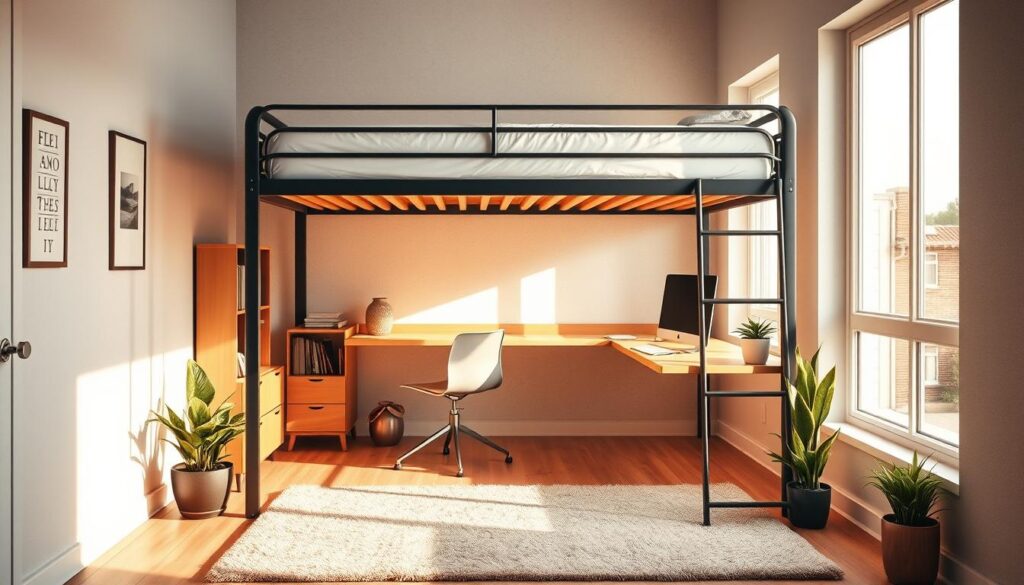
Desk Integration Under the Bed
Trofast storage units double as a sturdy desk base—ideal for bed storage and homework. Stack two units vertically, then top with a laminated pine board for a seamless work area. Source 2’s combo example shows how to add a chalkboard backrest for extra flair.
For kids aged 6–12, ergonomics matter. Pair the desk with an adjustable chair (like FLISAT) to prevent slouching. A clip-on LED lamp (£15–£20) ensures proper lighting without cluttering the workspace.
| Lighting Type | Best For | Cost Range |
|---|---|---|
| Clip-on LED | Small desks | £15–£20 |
| Wall-mounted | Permanent setups | £25–£40 |
Reading Corner Ideas
Turn unused floor space into a cosy book nook with layered cushions. Use washable covers (try JÄTTELIK) for easy maintenance. A hanging pendant light adds warmth—just keep cords out of reach.
One family completed their build in 24 hours (Source 1), using:
- Trofast bins for toy storage beneath the seating
- Non-slip rug pads to secure floor cushions
- Wall-mounted bookshelves (BILLY) within arm’s reach
7. Themed Bed Hacks: Dinosaurs, Castles, and More
Bring your child’s wildest dreams to life with these imaginative themed designs. Whether they’re obsessed with prehistoric creatures or fairy tales, a few clever tweaks can turn their sleeping space into an adventure zone. These ideas balance creativity with practicality, ensuring safety and fun.
Dinosaur Adventure Cave
Plywood cutouts make a roaring difference. Shape jagged “rock” panels to attach to the frame’s sides, painting them in earthy tones for realism. Source 1’s Hello Kitty playland proves how themed accents delight little ones.
For safety, round all edges and secure panels with child-friendly brackets. A removable canopy looks like a cave entrance—perfect for quick clean-ups.
Fairytale Castle with Turret
Trofast storage boxes become castle towers when stacked vertically. Add cone-shaped MDF roofs painted in pastel hues for a storybook effect. Source 2’s Union Jack example shows how bold colours define the theme.
| Design Type | Cost (DIY vs. Custom) | Longevity |
|---|---|---|
| Dinosaur Cave | £40 vs. £200+ | Temporary (peel-off decals) |
| Castle Turret | £60 vs. £300+ | Permanent (fixed structure) |
For shared rooms, mix themes—like a dragon-guarded castle beside a jungle den. Use lightweight materials to avoid overloading the frame. As one parent shared:
“The removable turret let us switch themes as the kids grew—no rebuilds needed!”
8. Multi-Functional Bunk Bed with Storage
Smart storage solutions can revolutionise small bedrooms, especially when combining sleep and organisation. A raised frame creates valuable space underneath for wardrobes or toy systems, perfect for growing families. Source 1’s decade-long use case proves these hacks stand the test of time.
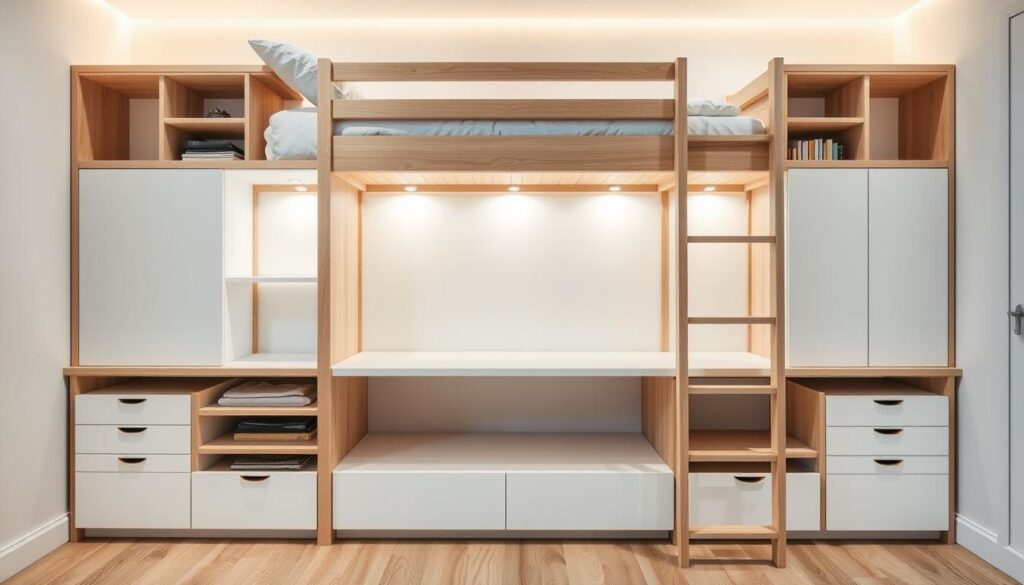
Built-In Wardrobes Underneath
Sliding wardrobes maximise storage space without sacrificing floor area. Source 3’s IVAR cabinet hack shows how to repurpose shelves into a compact closet. Use soft-close rails to prevent accidents—ideal for kids sharing a room.
For stability, distribute weight evenly across the frame’s legs. A 10-year user shared:
“We anchored the wardrobe to the wall and added castor wheels for easy access to back panels.”
Toy Storage Solutions
Modular systems like Trofast bins allow toy rotation, keeping clutter controlled. Open shelves suit frequently used items, while drawers hide smaller pieces. Consider your child’s height—place favourite toys within easy reach.
| Storage Type | Best For | Space Saved |
|---|---|---|
| Sliding Wardrobes | Clothes, shoes | Up to 1.5m² |
| Open Bins | Toys, books | 0.5m² per unit |
In shared rooms, assign colours or labels to each child’s storage zone. This fosters independence and reduces squabbles over missing toys.
9. Safety and Practical Tips for Kura Bed Hacks
Ensuring a secure sleeping environment is crucial when customising furniture for little ones. While creative designs spark joy, structural integrity and fall prevention should never be compromised. Follow these guidelines to balance innovation with peace of mind.
Age-Appropriate Modifications
For raised bunk setups, Limmaland recommends waiting until a child is at least six years old. Younger ones fare better with low-level configurations, reducing fall risks. Always anchor the frame to walls—IKEA’s 100kg weight limit includes added structures like canopies.
Ladder alternatives matter for toddlers. Replace vertical rungs with angled steps or integrate Trofast storage boxes as safer climbing aids. One parent shared:
“We added rubber grips to each step—our three-year-old climbs confidently without slips.”
Mattress and Rail Recommendations
Stick to mattresses no thicker than 12cm to prevent gaps between the mattress and rails. UK safety standards require guardrails on both sides for raised beds. Compare options:
| Rail Type | Best For | Installation |
|---|---|---|
| Permanent | Long-term use | Bolted to frame |
| Removable | Flexible layouts | Clip-on design |
For added safety, extend rails 15cm above the mattress. Check safety rail advice for DIY inspo. Soft-close mechanisms on drawers prevent pinched fingers—a small detail with big benefits.
10. Inspiring Real-Life Kura Bed Hack Examples
Discover how families worldwide have reimagined children’s furniture with clever diy projects. These real examples showcase ingenuity, from themed dens to space-saving study nooks. Each adapts to unique room sizes and interests, proving versatility matters most.
Treehouse Bed Adventure
Gizem’s Dutch drawer hack (Source 1) transformed under-bed space into pull-out storage. Using birch plywood, she crafted seamless drawers with football decals—perfect for a play area. Total cost? Just £45 for materials.
Kirsty’s football theme took it further. She added:
- Painted goalpost details on the frame’s sides
- Trofast bins as toy storage disguised as lockers
- A removable canopy with team colours
Hello Kitty Playland
Source 1’s two-storey build features a pink loft with a slide. The lower level houses a plush reading nook, while the top bunk includes safety rails styled as a castle balcony. Parents noted:
“Our daughter’s room became her favourite spot overnight—no more bedtime battles!”
Melissa’s Canadian hack adapted a discontinued frame into a jungle den. She used:
| Material | Cost (CAD) |
|---|---|
| Faux ivy garlands | £12 |
| MDF animal cutouts | £20 |
In a 300 sq.ft tiny home, one family maximised vertical space. They built a fold-down desk beneath the frame and added wall-mounted shelves. The project took one weekend and £80—proof that small spaces can pack big fun.
11. Conclusion
Transforming a child’s room with adaptable furniture brings endless possibilities. The versatile frame we’ve explored offers smart solutions for tight space, growing needs, and imaginative play—all without overspending.
Safety remains key. Always anchor structures securely and follow weight guidelines. Share your diy ideas in parenting forums—Source 1’s community proves collaboration sparks brilliant upgrades.
From toddler years to teen days, this piece evolves alongside your child. Ready to start? Grab tools, pick a theme, and create a space they’ll adore for years.
FAQ
What are the best paint options for personalising the Kura bed?
Water-based, non-toxic paints work best for a child’s room. Chalk paint offers a matte finish, while acrylics provide vibrant colours. Always sand lightly before painting for better adhesion.
How can I maximise storage in a small room with this bed?
Adding under-bed drawers or integrating Trofast storage units underneath creates extra space for toys, clothes, or books. Floating shelves on the sides also help keep the floor clutter-free.
What’s the easiest way to add a cosy canopy?
Lightweight muslin or cotton curtains hung from a simple tension rod create a soft, dreamy look. For a DIY option, use fabric and hooks to drape a canopy over the top bunk.
Can the Kura bed be turned into a playhouse?
Absolutely! A plywood roof structure or fabric drapes can transform it into a playhouse. Themed decals or wall stickers add extra fun without permanent changes.
How do I create a study nook underneath?
A small desk and chair fit neatly under the elevated frame. Add LED string lights or a clip-on lamp for a cosy study or reading corner.
Are themed bed hacks difficult to make?
Not at all! Simple additions like cardboard turrets for a castle or dinosaur decals bring themes to life. Most projects require basic tools and creativity.
What safety tips should I follow for modifications?
Ensure all changes are secure and age-appropriate. Use guardrails for younger children and check that the mattress fits snugly to prevent gaps.
Can the bed be used as a bunk for siblings?
Yes, with proper reinforcement and safety rails, it works well as a bunk. A thicker mattress on the bottom level adds comfort for the lower sleeper.

